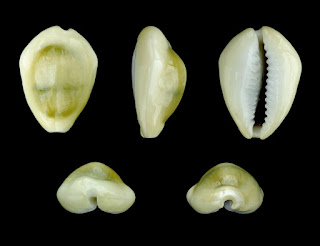Six silver coins were discovered in the ruins at Al-Khanoum in Afghanistan on 3rd October 1970, hidden in a pilgrim's water vessel. These depict Hindu deities and are coins of Indo-Greek King Agathocles, of Bactria of 190-180 BC.
Vasudeva-Krishna with Vishnu attributes of the Shankha and Sudarshana Chakra wheel on a coin of 180 BC
These are amongst the earliest coins with Vedic deities and display avatars of Vishnu, Krishna, Balarama (Krishna's brother), Lakshmi and Subhadra (sister of Krishna and Balarama). These coins from Al-Khanoum are precious indication of the forms taken by the Bhagavata cult and Vaishnavism in early India and shows that this cult was popular in the area of Gandhara around the 2nd century BC.
Agathocles of Bactria (190-180 BC). Son of Demetrius and in charge of the Paropamisadae between Bactria and Indus-Ganges plains who issued a vast range of bilingual coinage, displaying Buddhist and Hindu symbolism. The coins used Brahmi, Greek or Kharosthi scripts and he displayed willingness to accommodate local languages and beliefs to an extent unseen with subsequent Indo-Greek kings.
Krishna is worshipped in India as the eighth avatar of Vishnu. He is the central character in 'Mahabharata' and the 'Bhagwat Gita'. He is also called Vasudeva Krishna.
Balarama was the elder brother of Krishna, the Hindu God. He is also referred to as Baladeva, Sankarshan, Balabhadra and Halayudha and the deity who used farm equipment as weapons when needed as he was strongly associated with farmers and farming.
Subhadra is the sister of Krishna and Balaram, wife of Arjuna, mother of Abhimanyu and grandmother of Parikshit. Also known as Veera Sodari, Veera Patni and Veera Mata and is worshipped with Krishna.
Coins with Hindu deities
Left: Balarama-Samkarshana with Greek legend
Right: Vasudeva-Krishna or Lord Krishna with Shankha and Sudarshana Chakra, Brahmi legend
Several deities depicted on the coinage of Agathocles 180 BC with Brahmi legend.
From left,
1. Zeus standing with goddess Hecate
2. Deity wearing a long himation, arm bent
3. Balarama-Samkarshana
4. Vasudeva-Krishna with Brahmi legend
5. Goddess Lakshmi, holding a lotus in right hand
The statue of a Bodhisattva displays the same shaft with parasol as seen on the coins.
Maues coin with Samkarshana-Balarama, 1st Century BC, with a mace and plough, striding forward with billowing scarf,
Earliest representation of Balarama on a Mauryan Empire punch marked coin, 3rd century BC.
Enlargement of the "Balarama" of the coin above
Double Karshapana, 185-170 BC, weigh 14.4 gm.
Obverse: Deity Subhadra (Krishan's sister) moving left holding flower, Brahmi legend, Rajane Agahukleyasasa
Reverse: Panther standing right, Greek legend
Agathocles of Bactria, 190-180 BC, weight 9.8 gm
Obverse: Subhadra (Krishna's sister) walking to left, with a flower in her right hand, Brahmi legend
Reverse: Panther standing to right, Greek inscription
Pantaleon of Bactria, 185-180 BC, weight 12.7 gm
Obverse: Subhadra (Krishna's sister) walking to left, with a flower in her right hand, Brahmi legend
Reverse: Panther standing to right, Greek inscription
The first inscription of the Bhagvati cult (worshippers of Krishna) was by an Indo-Greek Heliodorus, an ambassador of king Antialcidas, who wrote a dedication on the Besnagar pillar in 2nd century BC. The Heliodorus pillar is a stone column erected around 113 BC in Besnagar (near Vidisha, Madhya Pradesh) and was called Garuda-standard. A dedication in Brahmi script inscribed on the pillar glorifies Vasudeva, the "God of Gods" and symbolizes joining earth, space, and heaven. The pillar and inscriptions were discovered in 1877. These contain some of the earliest known writings of Vasudeva-Krishna devotion and early Vaishnavism and considered as the first archeological evidence.
The Heliodorus Pillar in Vidisha, Madhya Pradesh, India, 113 BC
The inscription recites a verse from "Mahabharata", 113 BC
Silver coin of Agathocles, 180 BC,
Obverse: Diademed bust of king Agathocles
Reverse: Zeus holding Greek goddess Hecate in his hand, Greek legend
Buddhist coin of Agathocles with a six-arched hill symbol surmounted by a star Kharosthi legend Akathukreyasa "Agathocles". Tree in railing. Kharosthi legend "Hiranasame" 190-180 BC
Decipherment of Brahmi Script
Identical regnal names Agathuklayesa (Brahmi) and Agathocles (Greek) on a bilingual coin of Agathocles, used by Christian Lassen to decipher the first Brahmi letters.
However, it is ironical that its only from 1834 AD, that attempts to decipher the Brahmi script, the main script used in ancient Indian inscription like the Edicts of Ashoka were made by J Stevenson and in 1836 by Christian Lassen who used the bilingual Greek -Brahmi coins of Indo-Greek king Agathocles and Pantaleon to correctly identify the Brahmi characters. The task was completed by James Prinsep also taking help of Major Cunningham in 1838, leading to a large number of edicts being deciphered. Although it is quite possible that these were deciphered earlier too and all the records as also the deciphered scripts were destroyed in Nalanda when all the ancient scripts were burnt by Bakhtiyar Khilji, in 1200 AD.
Coin India































































